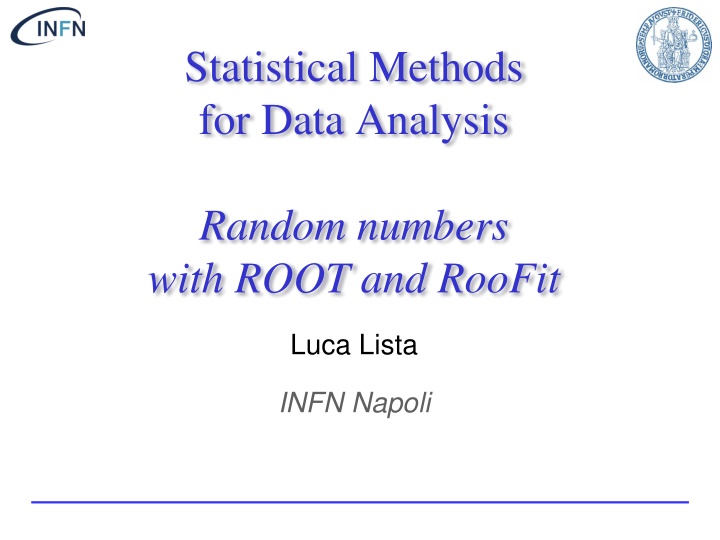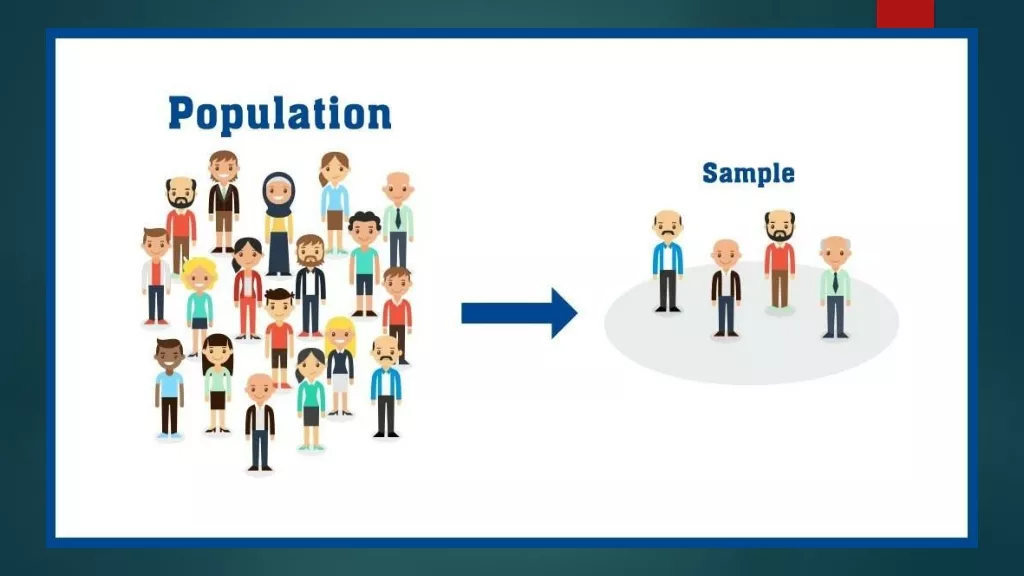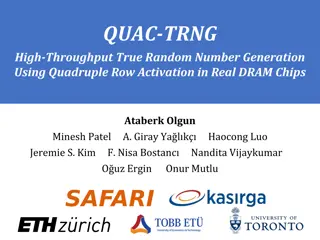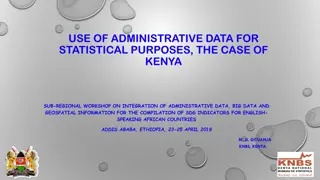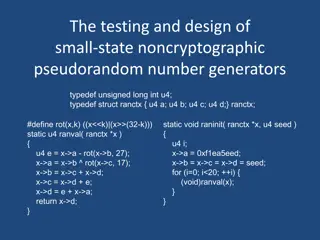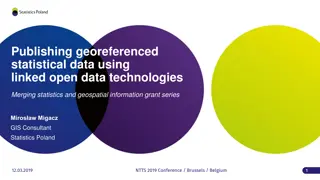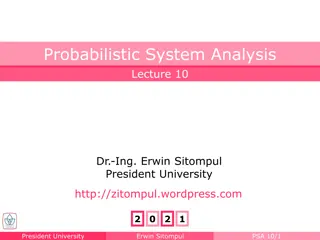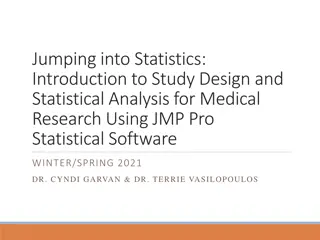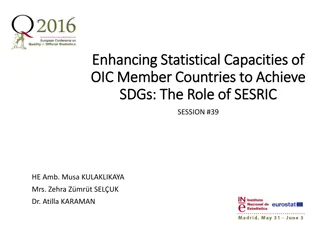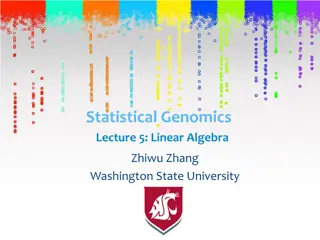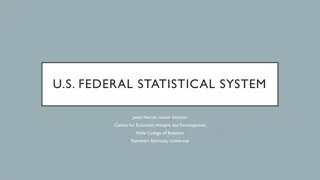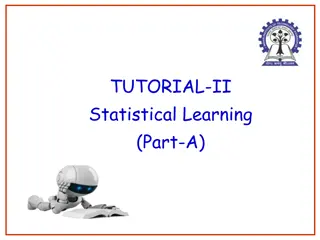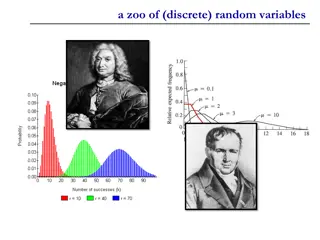Random Number Generators in Statistical Data Analysis
This content delves into the usage of random number generators with ROOT and RooFit for statistical data analysis, discussing various methods for generating random numbers and implementing standard probability density functions. It explores different generators provided by ROOT
Download Presentation

Please find below an Image/Link to download the presentation.
The content on the website is provided AS IS for your information and personal use only. It may not be sold, licensed, or shared on other websites without obtaining consent from the author.If you encounter any issues during the download, it is possible that the publisher has removed the file from their server.
You are allowed to download the files provided on this website for personal or commercial use, subject to the condition that they are used lawfully. All files are the property of their respective owners.
The content on the website is provided AS IS for your information and personal use only. It may not be sold, licensed, or shared on other websites without obtaining consent from the author.
E N D
Presentation Transcript
Statistical Methods for Data Analysis Random numbers with ROOT and RooFit Luca Lista INFN Napoli
ROOT Random number generators TRandom basic Random number generator class (periodicity = 109). Note that this is a very simple generator (linear congruential) which is known to have defects (the lower random bits are correlated) and therefore should NOT be used in any statistical study. TRandom3 based on the "Mersenne Twister generator", and is the recommended one, since it has good random proprieties (period of 219937 1, about 106000) and it is fast. TRandom1 based on the RANLUX algorithm, has mathematically proven random proprieties and a period of about 10171. It is however slower than the others. TRandom2 is based on the Tausworthe generator of L'Ecuyer, and it has the advantage of being fast and using only 3 words (of 32 bits) for the state. The period is 1026. Luca Lista Statistical Methods for Data Analysis 2
Generating with standard PDFs Provided methods of TRandomN objects: Exp(tau) Integer(imax) Gaus(mean, sigma) Rndm() RndmArray(n, x) Uniform(x) Uniform(x1, x2) Landau(mpv, sigma) Poisson(mean) Binomial(ntot, prob) Luca Lista Statistical Methods for Data Analysis 3
Generators in ROOT::Math Generators provided based on GSL (GNU Scientific Library) Same interface as TRandomN Different generators supported via template parameter (RANLUX, by F.James, in this case) ROOT::Math::Random<GSLRngRanLux> r; Double x = r.Uniform(); Luca Lista Statistical Methods for Data Analysis 4
Generate random from a TF1 ROOT provides tools to generate random number according to a TF1 TF1 f( ); double x = f.GetRandom(); TH1D histo( ); histo.FillRandom(f, 1000); Adopted technique: binned cumulative inversion Caveat: approximations may depend on internal function binning. Can change it using: f.Npx(5000); Luca Lista Statistical Methods for Data Analysis 5
Generate according to phase-spaces Original implementation: GENBOD function (W515 from CERNLIB) using the Raubold and Lynch method Implemented in ROOT with TGenPhaseSpaceclass TLorentzVector target(0.0, 0.0, 0.0, 0.938); TLorentzVector beam(0.0, 0.0, .65, .65); TLorentzVector W = beam + target; //(Momentum, Energy units are Gev/C, GeV) Double_t masses[3] = { 0.938, 0.139, 0.139 }; TGenPhaseSpace event; event.SetDecay(W, 3, masses); TH2F *h2 = new TH2F("h2","h2", 50,1.1,1.8, 50,1.1,1.8); for (Int_t n=0;n<100000;n++) { Double_t weight = event.Generate(); TLorentzVector *pProton = event.GetDecay(0); TLorentzVector *pPip = event.GetDecay(1); TLorentzVector *pPim = event.GetDecay(2); TLorentzVector pPPip = *pProton + *pPip; TLorentzVector pPPim = *pProton + *pPim; h2->Fill(pPPip.M2() ,pPPim.M2() ,weight); } h2->Draw(); Luca Lista Statistical Methods for Data Analysis 6
Random generation in RooFit Each PDF is instrumented with methods to generate random samples RooGaussian gauss("gauss","gaussian PDF", x, mu, sigma); RooDataSet* data = gauss.generate(x, 10000); RooPlot* xframe = x.frame(); data->plotOn(xframe); xframe->Draw(); Hit or miss method is used by default, except for optimized cases (Gaussian, ecc.) Optimized implementations for: PDF sum, product Convolutions Users can define a specialized random generator for custom PDF definitions Luca Lista Statistical Methods for Data Analysis 7
References RANLUX F. James, RANLUX: A Fortran implementation of the high-quality pseudo-random number generator of L scher , Computer Physics Communications, 79 (1994) 111 114 GSL random generators: http://www.gnu.org/software/gsl/manual/html_node/Random- number-generator-algorithms.html http://www.gnu.org/software/gsl/manual/html_node/Random- Number-Distributions.html ROOT Math generator documentation: http://project-mathlibs.web.cern.ch/project- mathlibs/sw/html/group__Random.html RooFit online tutorial http://roofit.sourceforge.net/docs/tutorial/ index.html Credits: RooFit slides and examples extracted, adapted and/or inspired by original presentations by Wouter Verkerke Luca Lista Statistical Methods for Data Analysis 8
